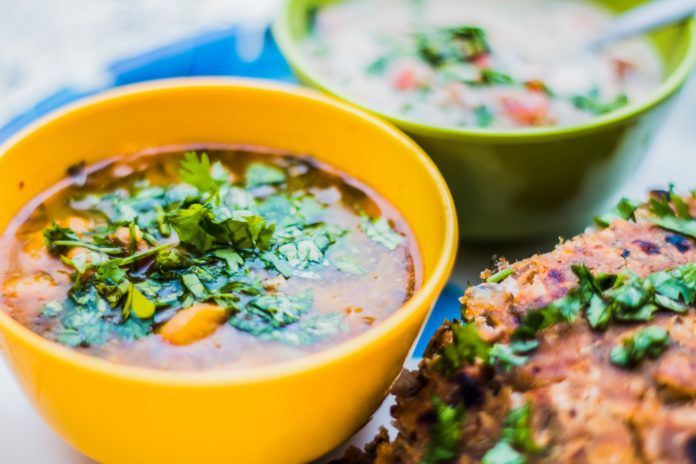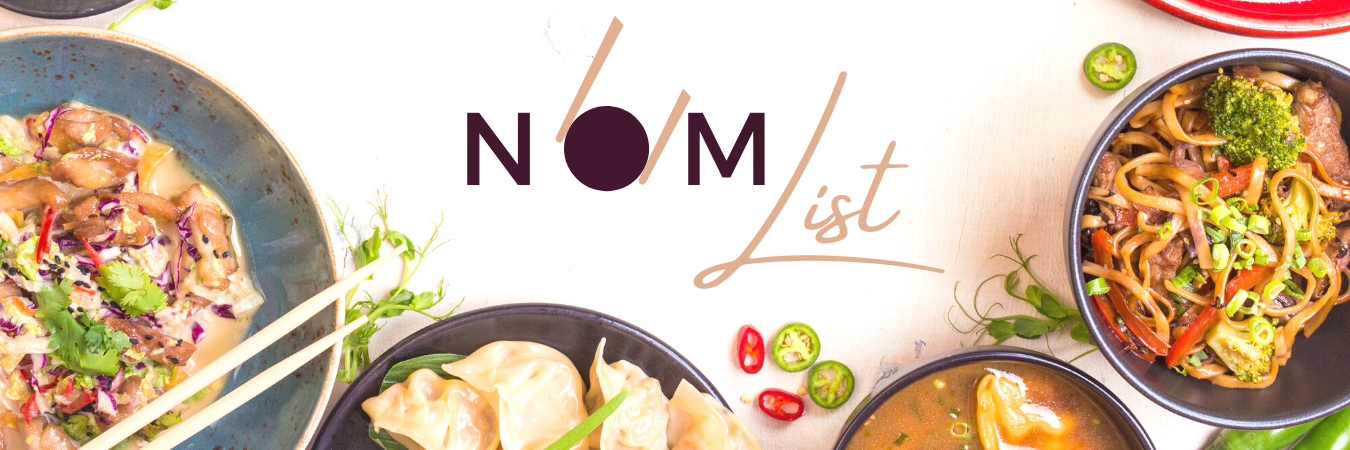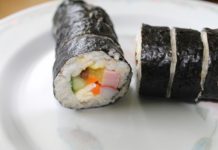
Vegetarians go through confinement after they have babies too. However, tradition dictates that a new mother during her confinement period is supposed to cram down as much meat as possible. There is a reason for it too. When a woman gives birth, she’s still eating for two. What she puts in her body ends up in her breast milk.
On top of that, confinement is not only used to create the healthiest baby possible but to help the mother recuperate from the trauma of child birth. To do that, she needs to replenish and rejuvenate her body inside and out. A big part of that process is replenishing the blood.
Where do humans get the stuff to generate new healthy blood? Protein! Where do we get protein? Not just in meats! Sure, older generations of women will tell you that you have to eat meat to have a healthy recovery or that you can’t do confinement on vegetarian food alone.
They’ll tell you that without enough meat you’ll get anemic or have fainting spells because you are too weak. Yet there are plenty of women who have survived the postnatal period on vegetarian confinement food alone and faired just fine. It is possible to give you and the baby all of the good stuff that you need from vegetables, beans, grains, and fruit alone.
Of course, it’s going to take a little more work to sustain you and your baby’s health with the limitations that come with a vegetarian diet. But on the plus side, you also won’t be passing on all of those saturated fats and carbs and cholesterol that come from animal protein. We’ve got your back – this is the ultimate guide to vegetarian confinement food!
What Is Confinement Food?
In case you missed the Ultimate Guide we wrote recently about halal confinement food, it is what ancient Chinese women called Zuo Yue Zi or translated, “sitting the moon.” It is the one month period after a woman gives birth where Asian tradition says that she must confine herself to the indoors.
Not only is she supposed to stay inside for one month, she’s also supposed to rest and relax by not lifting a finger, not even to bathe. Her mother or mother-in-law sets up shop in the house for that month and does all of the cooking and the cleaning while the mother tries to gobble up as much good food as possible.
Tradition says that a woman should eat about seven meals a day; meals jam packed with meats. Particularly in China, a woman in confinement’s diet is usually filled with pig parts and chicken plus tons of fish and fish soups. Older Asian women will tell you that the meat is the most important part of confinement food. So what is a vegetarian to do during confinement?
What Is Typical Vegetarian Confinement Food?
To begin with, no matter which part of Asia the tradition comes from, the goal of confinement food is to steer clear of cool or cold foods and to embrace “warm” foods. Many of the foods vegetarians can eat are included among the warm vegetables that are allowed during confinement. Some of the vegetables considered acceptable confinement food are:
Asparagus
Broccoli
Carrots
Green Beans
Kale
Mushrooms
Red Dates
Seaweed
Spinach
Whether you’re vegetarian or not, you’ll fill up on these types of vegetables during confinement. However, where meat eaters are able to fill their meals with fish, chicken, and pork, Vegetarians have to find protein and iron in other places. Fortunately many of the hearty foods that make up a vegetarian diet are also cleared for vegetarian confinement food, including:
Berries
Red Beans
Black Beans
Cashews
Papaya
Peanuts
Pine Nuts
Soybeans
Tofu
In addition to these foods, vegetarian confinement food like traditional confinement food includes lots of different herbs and spices with sesame and ginger rounding out the top two. Another thing that is the same for vegetarians and traditionalists is the types of beverages that you are limited to.
During confinement, you must stay away from cold foods, which includes ice water. You are not to drink caffeine so coffee and soda is out. You are basically limited to warm herbal teas. But you have to stay hydrated, that too is an important part of recovery from childbirth. Instead you’ll drink red dates tea, goji berry tea and the water you get from the fish soups that you’ll eat.
On the downside, for both vegetarians and meat eaters, cold foods are out and some of your favorites are probably on that list. For the month of the confinement period, you will have to go without:
Cabbage
Cold Beverages
Cucumbers
Lettuce
Mung Beans
Pineapple
Root Vegetables
Salad
It’s important for vegetarians to recognize that while salads are a big part of a daily diet, during confinement, many salad vegetables like lettuce are off limits.
What Are the Benefits of Vegetarian Confinement Food?
One of the perks of vegetarian confinement food is that during traditional confinement, trying to get rid of that baby fat through diet is out – at least for a month. In fact, over traditional confinement you have to do the opposite of dieting. Vegetarians still have to eat a bunch but without the saturated fats that come with eating meat.
Vegetarians tend to bolster their diets with potatoes and heartier vegetables. One downside is root veggies are out during confinement as are raw vegetables. Yet you’re still going to need to find foods that are iron rich and high in protein to replenish the blood after giving birth. Because vegetarian confinement food includes a lot of different kinds of foods, it makes it easier to steer away from meat and dairy while still getting all of the nutrition that you need.
What about Dairy?
Vegans eschew all animal byproducts. Vegetarians sometimes make exceptions for dairy. Ova-vegetarians are allowed to eat eggs but no milk or butter. Part of the goal of infusing so much food into your diet for those 30 days post-partum is to help with milk production.
Certain confinement food like papaya and certain nuts help new mothers lactate. The all vegetable and iron rich diet helps to make the breast milk healthy. Doing it the vegetarian way while staying away from full fat milk and opting for plant based dairy is an option for vegetarians. Although, most Asian cultures consider milk to be a cold food and should be avoided during confinement.
Should I Get Vegetarian Confinement Food Delivered?
There are services out there that deliver vegetarian confinement food if you don’t want to have to worry about what you can and cannot have. Nouriche in Singapore is one of several confinement food services that provide precooked meals to cover every day of the 30 day confinement period.
Angel Confinement Meals is another meal delivery service that provides all of the essential nutrients that new mothers need over confinement. For this service, you get to pick which meals you want and how many meals you need delivered each day. Maybe you only have dinner delivered but make breakfast, lunch, and snacks?
Phoenix Signature Kitchen offers dozens of delicious looking vegetarian confinement meals for delivery. These meals are chock full of all of the good stuff you need to get through confinement. They offer different packages that focus on milk production with their tasting lactate inducing cookies!
DIY Vegetarian Confinement
Now that you have the dos and don’ts of vegetarian confinement, you may want to just try to manage your meals yourself. It may not be as difficult as you think. It’s quite possible that being vegetarian may help you fit in all 7 meals a day since you may end up hungrier than women stuffing their face with pig’s feet and liver.
If you DIY your vegetarian confinement, each week is supposed to help your body do certain things. Week one post-partum is about building up your milk production. You won’t have fish soup and liver to help spur production but some of the vegetarian confinement food you want to fit in over week one includes:
Dang Shen Tea
Ginger
Herbs
Kidneys
Porridge
Red Dates Tea
Steamed Eggs
Week two gets the milk flowing and is meant to get your blood back in fighting shape. For traditional confinement, this week is packed with meats like ham hock, pig’s feet, and loin of pork. Without those protein packed foods, you’ll need to lean heavy into the ova-vegetarian in you and fry lots of eggs. You’ll eat loads of ginger, sesame oil, papaya, and whole grains.
After your first two weeks of confinement, the goal is to rejuvenate your body with the foods you eat while continuing to nourish your baby with top quality breast milk. Over traditional confinement, seafood reappears in the final two weeks as well as shellfish.
For vegetarian confinement food over the last two weeks, you’ll steer clear of shellfish and seafood but you can lean into tofu and nuts. Also, you’ll want to mix in lots of warm fruits, vegetables, dates, and kelp to keep boosting iron production.
10 Easy At-Home Vegetarian Confinement Food Recipes
Eating vegetarian doesn’t mean choking down rice cakes. There are some delicious vegetarian confinement food recipes to pick from that will keep you fat and giggly the entire month. Here are a few easy recipes as well as some recipes that will help you meal plan over the four weeks of your confinement period.
Breakfast
Rather than thinking of the things that you can’t have over confinement, it helps to think about the things that you can have. We found two breakfast recipes for vegetarian confinement that you will really dig!
Fruit and Nut Steel-Cut Oatmeal
You’ll need:
2 Tablespoons of Coconut Oil
¼ Cup of Maple Syrup
1 Cup of Fresh Berries
1 Cup of Chopped Nuts
4 ½ Cups of Water
1 Teaspoon of Ginger
1 Teaspoon of Salt
You’ll need to know how to make steel-cut oats – it’s like instant oatmeal except sturdier and they take a lot longer to cook. Here are several kick ass steel-cut oatmeal methods from a self-declared expert. One you make the oats, you will top it with coconut oil, syrup, berries and nuts. Finally, you will season it to taste with salt and ginger. The beauty of this recipe is that steel-cut oatmeal is reheatable. You can make a big old pot of it and eat it over the first week of confinement to make breakfast easy-peasy.
Another great vegetarian confinement food is this recipe for a Breakfast Omelet with Ginger. It’s really simple. You just beat two eggs, shred two slices of ginger, and then add them to a wok with hot sesame seed oil in it. Fry it all together and you have a delicious quick and easy vegetarian confinement breakfast.
Lunch
For lunch, a great idea for confinement is to make a great big pot of stew that you can eat on throughout the week. Traditional confinement stews pack in the pork and chicken, but here is a simple stew that loses nothing when you omit the chicken and ribs.
It’s 8 cups of boiling water with a clove of garlic added to it. Then papaya, peanuts, red dates, and lotus root are added to the stew. Let it cook for two hours and serve. A similar chicken stew can easily be turned in to a Red Bean or Black Soy Bean Soup by adding those beans plus a peeled carrot and two diced tomatoes to this recipe. Simply season with salt to taste and you have two very hearty meals for lunch.
Dinner
Here’s a quick vegetarian confinement dinner that only takes 15 minutes total to cook and serve. Over the course of confinement women are supposed to eat a lot of ginger. This recipe comes from Asian Parent and is super easy to make:
Ginger Fried Rice
You’ll need:
4 Thin Slices of Ginger
2 Cups of Cooked Rice
3 Tablespoons of Sesame Oil
Salt and Coriander
You’ll heat the wok for stir-fry using sesame oil. Throw in the slices of ginger first and brown it. Next toss in the cooked rice and season with salt; let the ginger and rice stir-fry for about 3 minutes and remove from heat. You’ll top it all off with some coriander and sesame seeds, lightly toasted.
With vegetarian confinement food, you may want to mix and match a couple of dinner recipes in order to get to the number of calories you need to be taking in every day. This recipe goes great with the Ginger Fried Rice:
Young Corn and Sweet Peas Stir-Fry
You’ll need:
½ Cup of “Young” Corn
½ Cup of Sweet Peas
4 Cloves of Chopped Garlic
1 Tablespoon of Sesame Oil
1 Teaspoon of Corn Flour
2 Teaspoons of Cold Water
1 Teaspoon of Soy
1 Tablespoon of Rice Wine
1 Tablespoon of Sesame Seed Oil
1 Teaspoon of Sugar
¼ Teaspoon of Salt
½ Cup of Water
First, mix the 2 teaspoons of cold water with the 2 teaspoons of corn flour. Boil corn for 3 minutes and then slice them in half long ways. Heat up the sesame seed oil in the wok. Add the sweet peas first and stir-fry for two minutes. Next add the corn and continue to stir-fry. Now add seasoning and the half cup of water until it comes to a boil. Finally stir in the corn flour mixture until it thickens up. Dinner is served!




